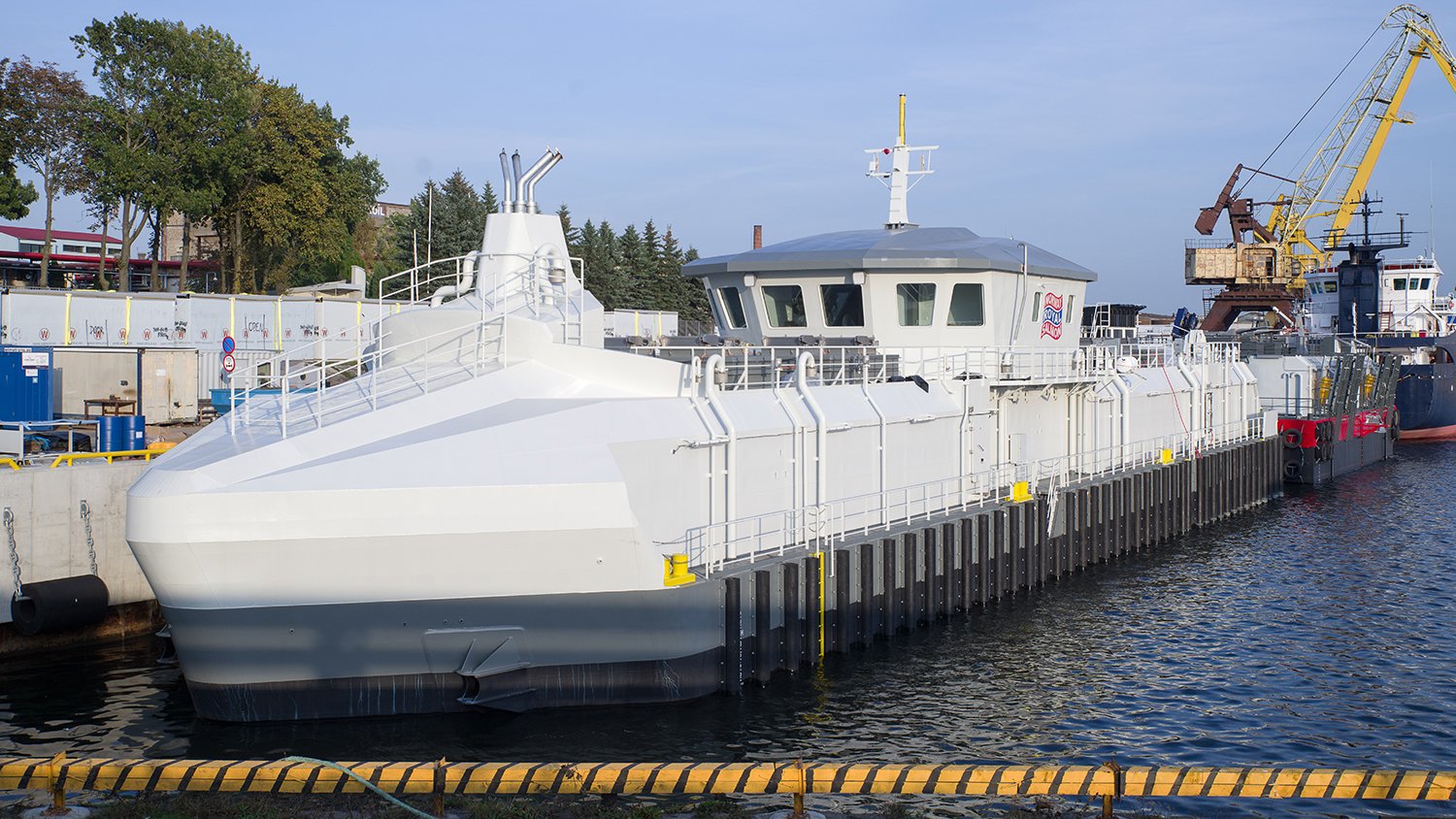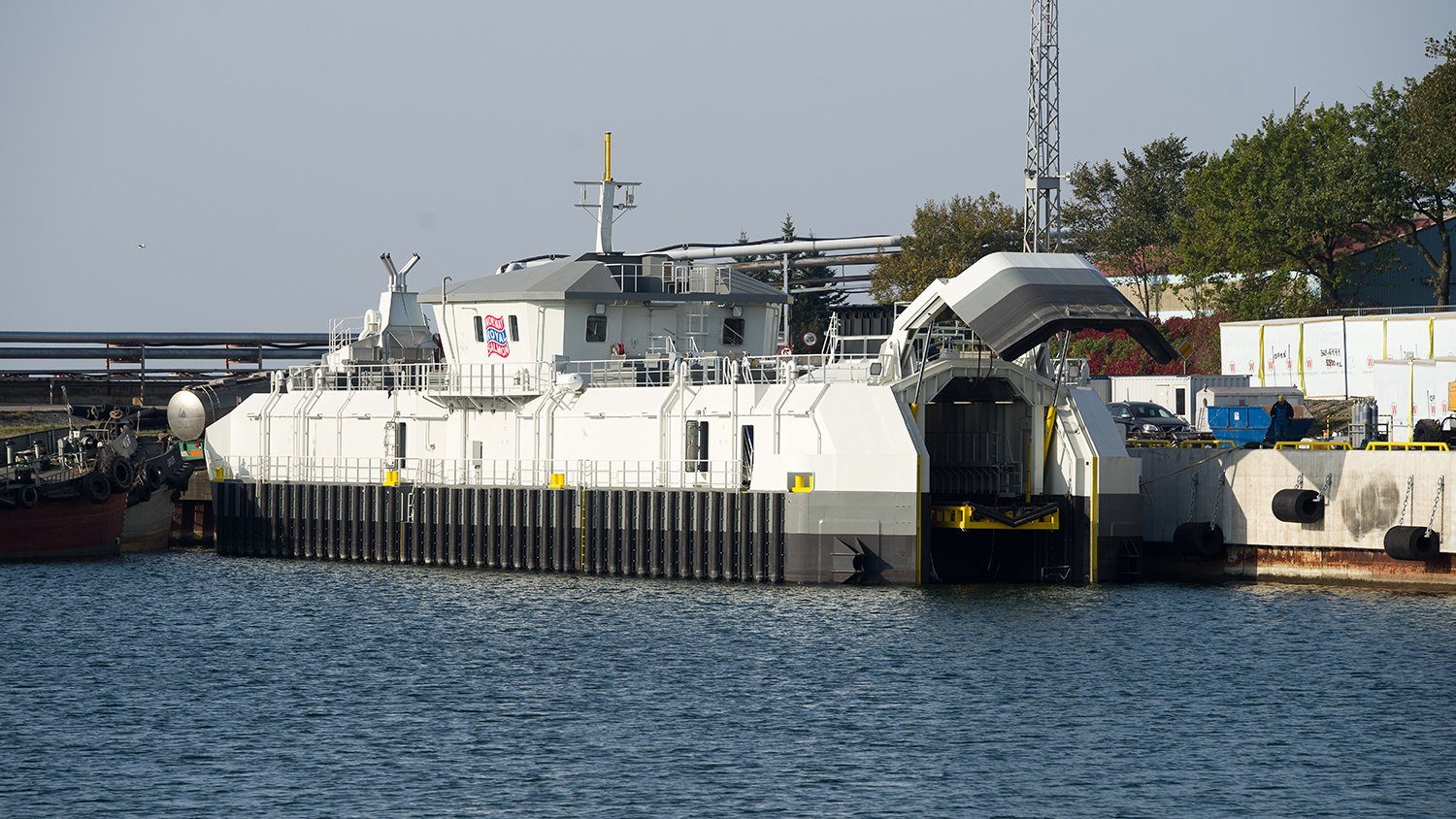Arctic Offshore Farming has invested in a new type of feed barge model in steel that excels in size and robustness. The giant barge also has a very environmentally friendly feeding system.

CONTRASTS: The feed barge from AKVA group excels in size and robustness with a length of 64.8 meters. A standard feed barge, an AC450C from AKVA group (in red) at the rear end demonstrates the size ratio.
Arctic Offshore Farming AS (AOF) is a wholly-owned subsidiary of Norway Royal Salmon ASA (NRS). In 2018, NRS/AOF was awarded development licenses from the Norwegian Directorate of Fisheries to develop semi-submersible steel structures (cages) for salmon farming in Troms in Northern Norway. Two pens with a total capacity of 5990 MTB are being built for the location Fellesholmen west of Tromsø. The fish farm is controlled and managed from a joint feed and service barge, developed in collaboration with, and built by, AKVA group. The pens will be ready to be populated in the summer of 2021 with the first fish produced ready for delivery to the market in 2022.
A feed and service barge with a similar combination of characteristics has not previously been delivered in the aquaculture industry.
"This is the toughest barge AKVA group has ever made and it can handle «weather from all sides»," says Kent Ims Borsheim, Project Manager in AKVA group.
{{cta('faf97e3a-5e9a-4caf-85af-d227e9e233ed')}}
The feed and service barge AC800PVDB has a unique composition; it is over 64 meters long and built for extreme conditions with a total tonnage of 800 metric tons, brand new environmentally friendly waterborne feeding technology and dimensioned for a significant wave height of 6.5 meters - specially designed for exposed locations. This is also the first barge that is designed with a bottom outlet for feed hoses in order to be able to use all sides of the barge for e.g. receiving feed. In addition, the barge is equipped with an integrated boat garage that can handle boats up to 10.5 m at the stern.
"We have great respect and are very grateful that NRS/AOF trusted us to develop this feed barge that represents the extreme in many ways; with requirements to withstand very harsh weather conditions, facilitated for large load capacity operations, the environmental effects of the actual feeding technology and not least a good working environment for the crew on board," says Hans-Øyvind Sagen, Sales Director Nordic in AKVA group.

BOAT GARAGE: The feed barge has its own entrance and garage for boats at the stern.
Huge energy savings
AKVA group has designed the barge with new technology for waterborne feeding, which was first presented at AquaNor in 2019. This is the second feed barge to be delivered with the new type of waterborne feeding technology.
"With waterborne feeding, the barge is very quiet in operation and environmentally friendly," says Borsheim.
Waterborne feeding represents a shift to extremely low energy consumption compared to air transport of the feed. Tests carried out during the development of waterborne feeding showed an energy reduction of as much as 70-90 per cent compared with air transport.
"The low energy consumption in feeding represents a significant cost saving in generator operation - approx. NOK 200,000 in monthly savings for a conventional feeding system with 8-10 pens," says Borsheim.
Deep feeding and constant capacity
With air feeding, the feeding capacity is up to 200 kg per minute at distances up to 50 meters, and then the feeding capacity decreases rapidly over long distances. With waterborne feeding, feeding capacity will be almost constant, regardless of the length of the feeding hose.
"We have measured the feeding capacity of waterborne feeding up to 600 meters, and the feeding capacity of 100 kg was fairly constant even with this feeding hose length," says Borsheim.
There are still issues that should be highlighted regarding the effects of waterborne feeding versus air feeding, and how the operation and technology should be adapted to optimize the operation and environmental benefits.
"Waterborne feeding also provides good conditions for "deep feeding" which is a prerequisite for exposed locations, and apart from lower lice pressure "at depth", there are several solutions that are being worked on to facilitate good fish welfare and better growth at "deep operation", including light conditions and feed distribution," says Hans-Øyvind Sagen, Sales Director in AKVA group Nordic.

TOWED TO NORTHERN NORWAY: The AC800PVDB is being towed from the shipyard in Tallinn to Fellesholmen west of Tromsø; Northern Norway.
Feed Barge AC800PVDB
- Feed storage capacity: 800 metric tons
- Length 64,80m and width 12m
- Silos: 12 with automatic hatch openers
- 8 feeding lines with waterborne feeding (with bottom barge exit)
- Double conveyer for flexible feed distribution to the feed hoses
- V-shaped hull
- Certified for 6.5 meter significant wave heights
- Equipped with 4 Nogva (2x200kva generators and 2x375kva generators)
- Living quarters including control room, 6 cabins, 3 bathrooms, kitchen, wardrobes and more
- 2 veterinary rooms with workstations (1 wet-lab and 1 dry-lab)
- Reversed osmose: The barge is self-sufficient with fresh water - produced by seawater. Industrial water tank is also connected to fresh water and can be filled up during production. These tanks can be refilled from boats if necessary
- EVAC treatment facility. A treatment facility cleans the septic. The waste is taken care of by EVAC
- The barge is equipped with a boat garage in the stern. A garage door opens for a boat (Polarcirkel 1050), and a slipway lifts the boat to dry. Water is pumped out of the garage via a ballast system. The system has been developed and installed with the greatest possible safety for the crew in mind; they should be able to enter and exit the boat while safe inside the garage. The boat garage is also used for boat storage in bad weather (instead of being exposed next to the barge).
- The barge is equipped with a ballast system (336m3 - 6 tanks) to lower/lift the barge using a trim/tilt indicator in the control system
- The silage system is the best of the best; a 2-stage system that allows you to partial mixing in the grinder tank and continue mixing in the other tanks
- The barge has a completely new control system for barge control - AKVAconnect 4.0
- In addition to the feed hose outlet below the barge, there are also outlets for power cables, signal cables and air hoses to the pens below the barge